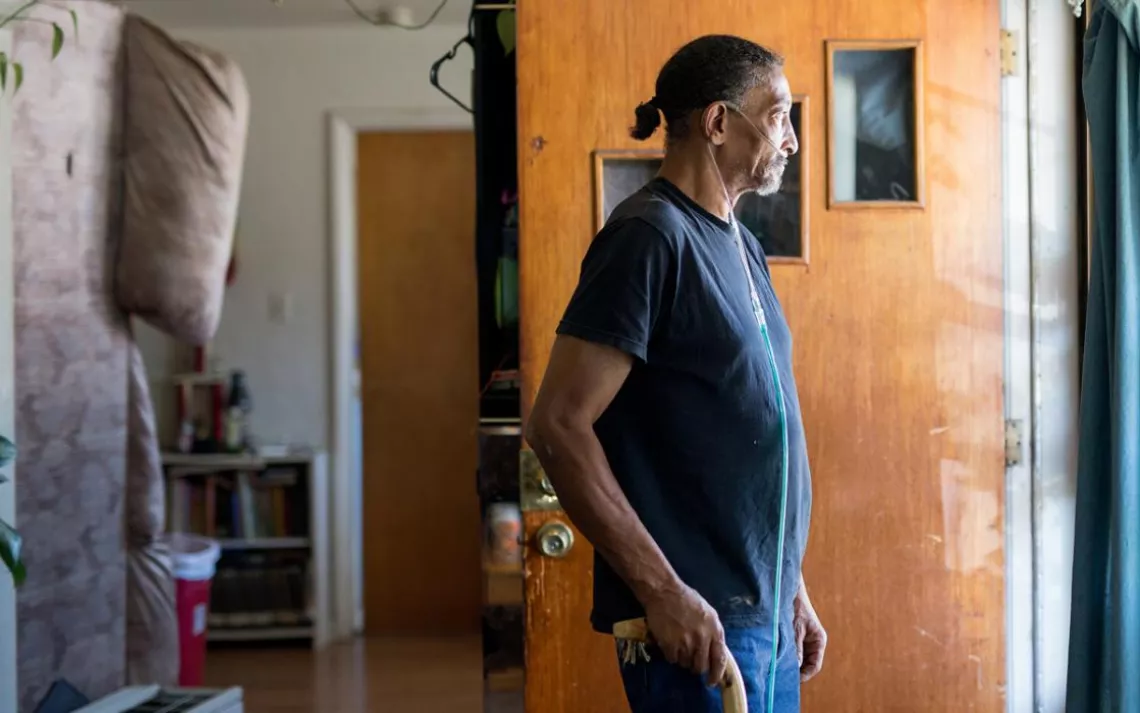Electric Utility Ratepayers Are Fed Up With Expensive, Dirty Energy
A power struggle in Pueblo, Colorado: Another gas plant or 100 percent clean energy?

Photos by Dana Romanoff
MICHAEL TANNAHILL IS HOLDING a sealed plastic bag containing his electric bill. He opens the bag, his foot jittering. "Pop . . . puff," sounds his oxygen machine.
Tannahill has two problems that are inseparable, each aggravating the other. One, he has a lung disease that makes it hard for him to breathe. Two, he has this electric bill.
The bill is for $1,370, a combination of missed payments and late fees exceeding Tannahill's monthly disability check of $1,045. Because of this bill, Black Hills Energy shut off the electricity in his Pueblo, Colorado, home two years ago. Since then, the company has turned it back on three times—two times for 30 days each, after his doctor sent a note on his behalf; another time for four months, after the landlord agreed to put the electricity bill under his name so the house's pipes wouldn't freeze. ("Not so I wouldn't freeze," Tannahill clarifies.) Now the electricity is off again, until Tannahill pays in full, and the landlord is threatening eviction.

A Black Hills Energy power planet near Pueblo, Colorado
Without electricity, Tannahill cannot power his oxygen machine, and without the machine, he cannot breathe. That's why he bought a gas generator for $400 last year, and why he
bought a new generator for another $400 when the first one was stolen. Tannahill feeds the generator $150 worth of fuel every month; it emits a steady whir outside his living room window.
On his couch in May, Tannahill wears four layers and thick socks. The generator powers a space heater, which is markedly less effective than the house's boiler. The colder Tannahill becomes, the more trouble he has breathing and the greater his chance of landing in the hospital again. The last time he was hospitalized, it was for a month and he missed an electric bill, which is how his problems with Black Hills Energy began in the first place.
A MILE FROM TANNAHILL'S HOME, a coalition of advocates called Pueblo's Energy Future hosted a standing-room-only town hall meeting one Thursday night in March. The attendees—students, a lawyer, an engineer, and a pastor, among many others—had one thing in common: They were fed up with their electric company. "If you want to hear what I think about Black Hills," one Puebloan said, "you'll need to bring a therapist and a full thermos of coffee."
Since Black Hills began servicing Pueblo in 2008, the city's energy prices have increased by more than 70 percent, making Pueblo's rates among the highest for Colorado cities and putting electricity out of reach for many. Last year, Black Hills disconnected more than 7,000 customers—out of the city's 43,000 households—for nonpayment.
Black Hills attributes the rate spike to its many recent construction projects: The utility used to resell power from Xcel Energy to its customers, but in 2012, Xcel terminated the agreement, forcing Black Hills to find new power sources. Around the same time, Colorado passed the Clean Air, Clean Jobs Act, which motivated Blacks Hills to replace a coal plant and a decommissioned natural gas facility with two wind farms and a cleaner natural gas peaking plant.
Ratepayer advocates question the necessity of the latter, a $65 million plant that sometimes only runs a few days per year, on hot days when everyone simultaneously turns on their air conditioners. Activists argue that Black Hills could have forgone the peaking plant by incentivizing demand-side energy efficiency instead.

Sister Nancy Crafton, a former nurse and now head of the Catholic charity El Centro de Los Pobres
The problem is, the utility has a financial incentive to build. "The way utilities make money is not by actually selling electricity but by building infrastructure," says Meral Cooper, who works on the issue for Pueblo's Energy Future and the Sangre de Cristo Chapter of the Sierra Club. Colorado's Public Utilities Commission (PUC) authorizes Black Hills to recover a 7.43 percent rate of return from building projects. That means that the more the company builds, the more it earns—and the more customers pay to cover construction costs.
Christopher Burke, vice president of electric operations for Black Hills, emphasizes that the decision to build the peaking plant wasn't Black Hills' alone. The PUC, which approves all capital spending and associated rate increases, made the ultimate call. Ratepayers in Pueblo question whether the PUC—one of whose newest members is a former senior Black Hills attorney—actually represents their interests. "Look, there's a conflict of interest here," says Pastor Kevin Olsen, who is also an organizer with Pueblo's Energy Future. "We don't want a PUC that just rubber-stamps whatever the utility company asks for."
Whether or not the peaking plant was a good idea, now that it's built, Puebloans like Tannahill have to pay for it. And when they don't, they're disconnected from the grid, no matter the weather or their reason for missing a payment. Not that Black Hills is hard up—its parent corporation's earnings per share rose by 80 percent from the first quarter in 2016 to the first quarter of this year.
THE MOST SCARED TANNAHILL EVER FELT was the time he tried to help his landlord install a water heater and he suddenly lost his breath. He sat down and considered calling an ambulance but realized he couldn't move. This was scarier, he says, than getting clubbed six times on the head as a prison guard. Scarier than doing four and a half years in the same prison he'd worked in. Scarier than learning that his son had died in a car accident. Scarier than serving in Vietnam.
Leaning against the water heater, Tannahill began hyperventilating. He searched his pockets for his inhaler, took two puffs, and finally recovered his breath half an hour later.
Back when he was healthier, Tannahill liked to walk. He'd walk three hours north, rest, and walk three hours back, "simply enjoying being outside." As he walked, he settled on a mantra that felt cliched but also utterly true: "How precious life is." Later, as he grabbed his chest next to the water heater, Tannahill repeated that same bromide, but this time with wild urgency. He wanted life.
"I hope I never feel like that again," he says.
When his electricity bills began piling up, Tannahill looked for help. He contacted his congressional representative, the Veterans Administration, and the county commission. Someone at the latter contacted a local Catholic charity called Los Pobres, run by Sister Nancy Crafton, a retired clinicalnurse specialist. Before Black Hills became the utility provider for Pueblo, Los Pobres paid out $23,000 per year helping the city's poorest keep the lights on. Now that Black Hills is in charge, that figure has risen to $58,000.
But the day the commissioner's office called, the charity's utility fund was empty. That didn't stop Crafton, who paid $600 of Tannahill's bill with her own money.

Downtown Pueblo, Colorado
AT THE TOWNHALL MEETING, some proposed a radical idea: How about driving Black Hills out of Pueblo?
Puebloans have a history of standing up to big business. For generations, many of them worked in the city's steel mills, feeding the blast furnaces that still stand along I-25, tall, domed, and serious. The workers emerged each evening covered in crushed coal, but they understood their own value. In 1997, Pueblo's steelworkers went on strike, and they did not return to work until seven years later.
Ousting a utility company, especially one contracted with the city through 2030, won't be easy or quick, but the idea is gathering support. Pueblo's Energy Future now has more than 600 people on its email listserv. Of the 100 people who attended its March town hall meeting, four were city council members. "All the years I've been on council—that's seven years—there has been no issue in this community that I have gotten more calls over than the cost of electricity," says council president Steve Nawrocki. "Each year, I kept thinking there would be a better Black Hills, but now I think that's an oxymoron."
Last February, six of the city council's seven members voted to commit to generating 100 percent of the city's power from renewables by 2035 as part of the Sierra Club's Ready for 100 campaign. Its vote does not directly affect Black Hills, as the council does not have the authority to impose energy standards on the utility. But, says Cooper, "with this commitment, what we're saying is we're not going to be pushed around by any of these corporations anymore."
Puebloans don't yet know whether they can actually give Black Hills the boot or what they'll replace it with if they do. A municipal utility? A co-op like the one on Hawaii's Big Island? Whatever it ends up being, Pastor Olsen calls for the new utility to prioritize energy equity. "Let's make our utility reflect the heart of this community. Let's make it caring and compassionate, generous, and fair," he says.
AFTER CRAFTON PAYS THE $600, Tannahill asks Black Hills to put him on a payment plan for the remaining $770. Black Hills denies his request.
So Tannahill continues to live with the limitations of his generator—cooling his food in a half-size refrigerator, running only one heater at a time, borrowing his girlfriend's rechargeable oxygen machine instead of using his plug-in model.
One morning, Crafton finds two envelopes in her mailbox. Inside are two checks from two benefactors for $400 each. That afternoon, Crafton calls Tannahill to tell him that his bill has been paid. Tannahill can expect his electricity to return that day.
At the other end of the line, Tannahill is momentarily speechless. He brings the phone closer to his ear. He taps his foot. The oxygen machine breaks his silence: "Pop . . . puff."
This article appeared in the September/October 2017 edition with the headline "Power Hungry."
WHAT YOU CAN DO
Pueblo did it—your city can, too. Get involved with the Ready for 100 campaign and tell your mayor that you want 100 percent clean and renewable energy in your community: sc.org/cleancities.
More Online
Watch a video about how Pueblo residents are waging a campaign for clean, renewable energy: sc.org/pueblovideo.
 The Magazine of The Sierra Club
The Magazine of The Sierra Club



